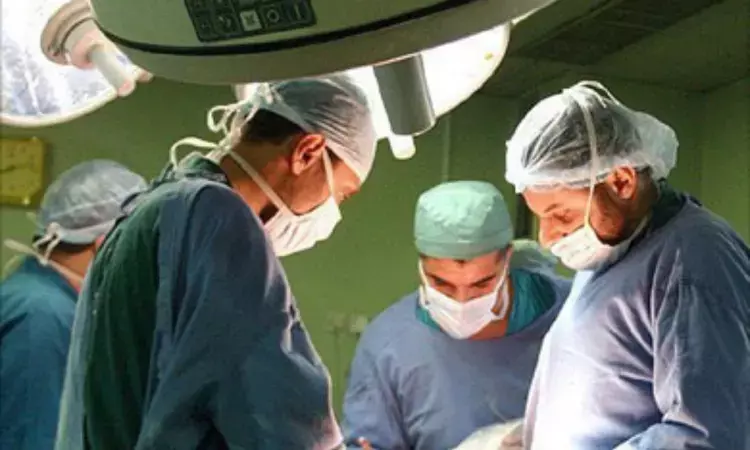- Home
- Medical news & Guidelines
- Anesthesiology
- Cardiology and CTVS
- Critical Care
- Dentistry
- Dermatology
- Diabetes and Endocrinology
- ENT
- Gastroenterology
- Medicine
- Nephrology
- Neurology
- Obstretics-Gynaecology
- Oncology
- Ophthalmology
- Orthopaedics
- Pediatrics-Neonatology
- Psychiatry
- Pulmonology
- Radiology
- Surgery
- Urology
- Laboratory Medicine
- Diet
- Nursing
- Paramedical
- Physiotherapy
- Health news
- Fact Check
- Bone Health Fact Check
- Brain Health Fact Check
- Cancer Related Fact Check
- Child Care Fact Check
- Dental and oral health fact check
- Diabetes and metabolic health fact check
- Diet and Nutrition Fact Check
- Eye and ENT Care Fact Check
- Fitness fact check
- Gut health fact check
- Heart health fact check
- Kidney health fact check
- Medical education fact check
- Men's health fact check
- Respiratory fact check
- Skin and hair care fact check
- Vaccine and Immunization fact check
- Women's health fact check
- AYUSH
- State News
- Andaman and Nicobar Islands
- Andhra Pradesh
- Arunachal Pradesh
- Assam
- Bihar
- Chandigarh
- Chattisgarh
- Dadra and Nagar Haveli
- Daman and Diu
- Delhi
- Goa
- Gujarat
- Haryana
- Himachal Pradesh
- Jammu & Kashmir
- Jharkhand
- Karnataka
- Kerala
- Ladakh
- Lakshadweep
- Madhya Pradesh
- Maharashtra
- Manipur
- Meghalaya
- Mizoram
- Nagaland
- Odisha
- Puducherry
- Punjab
- Rajasthan
- Sikkim
- Tamil Nadu
- Telangana
- Tripura
- Uttar Pradesh
- Uttrakhand
- West Bengal
- Medical Education
- Industry
Erector Spinae Plane Block OK for Postoperative Analgesia among Pediatric patients undergoing hypospadias repair: Study

The caudal block is the commonly employed regional technique in children undergoing hypospadias repair to manage postoperative pain. Recent study evaluated the effectiveness of sacral erector spinae plane block (ESPB) for postoperative analgesia in pediatric patients undergoing hypospadias repair. The study was a randomized controlled trial involving 40 children aged 2–7 years with ASA grade I or II. After general anesthesia induction, group I received ultrasound-guided sacral ESPB with 1 ml/kg of 0.25% bupivacaine, while group II did not receive the block. Pain was assessed using the FLACC scale, and rescue analgesia was given when the FLACC score was ≥4. The primary objective was to compare postoperative analgesic (paracetamol) consumption, and the secondary objective was the time to first rescue analgesia.
The results showed that mean postoperative paracetamol consumption was significantly lower in group I (360 ± 156.60 mg) compared to group II (997.50 ± 310.87 mg), and the time to first rescue analgesia was significantly longer in group I (906 ± 224.51 min) compared to group II (205.00 ± 254.92 min). The study concluded that sacral ESPB effectively reduced postoperative analgesic consumption in pediatric patients undergoing hypospadias repair.
Study Design and Procedure
The study design was a prospective, randomized, and double-blind comparison. The sacral ESPB was found to be safe and effective in all patients, and no complications were observed in any patient. The sacral ESPB was performed using aseptic techniques under ultrasound guidance, and patients remained hemodynamically stable intraoperatively. The study found that the sacral ESPB provided effective pain relief and extended the time to first rescue analgesia, indicating its potential as an alternative to caudal block for pediatric hypospadias repair.
The study's findings were consistent with previous case reports on the effectiveness of sacral ESPB in various surgeries. The sacral ESPB was observed to have advantages such as ease of administration, widespread local anesthetic spread, and lack of motor block. Overall, the study demonstrated that sacral ESPB is effective at reducing postoperative analgesic consumption and providing prolonged pain relief in pediatric patients undergoing hypospadias repair. This supports the potential use of sacral ESPB as an alternative regional technique in pediatric surgical procedures.
Key Points -
- The study design was prospective, randomized, and double-blind. The sacral ESPB was found to be safe and effective in all patients, and no complications were observed. The procedure was performed using aseptic techniques under ultrasound guidance, and patients remained hemodynamically stable intraoperatively. The sacral ESPB provided effective pain relief and extended the time to first rescue analgesia, suggesting its potential as an alternative to caudal block for pediatric hypospadias repair.
- The findings of the study were consistent with previous case reports on the effectiveness of sacral ESPB in various surgeries. The technique was observed to have advantages such as ease of administration, widespread local anesthetic spread, and lack of motor block. The study demonstrated that sacral ESPB effectively reduced postoperative analgesic consumption and provided prolonged pain relief in pediatric patients undergoing hypospadias repair, supporting its potential use as an alternative regional technique in pediatric surgical procedures.
Reference –
Bansal T, Yadav N, Singhal S, Kadian Y, Lal J, Jain M. Evaluation of USG‑guided novel sacral erector spinae block for postoperative analgesia in pediatric patients undergoing hypospadias repair: A randomized controlled trial. J Anaesthesiol Clin Pharmacol 2024;40:330‑5
MBBS, MD (Anaesthesiology), FNB (Cardiac Anaesthesiology)
Dr Monish Raut is a practicing Cardiac Anesthesiologist. He completed his MBBS at Government Medical College, Nagpur, and pursued his MD in Anesthesiology at BJ Medical College, Pune. Further specializing in Cardiac Anesthesiology, Dr Raut earned his FNB in Cardiac Anesthesiology from Sir Ganga Ram Hospital, Delhi.


